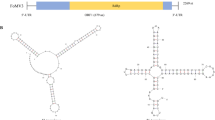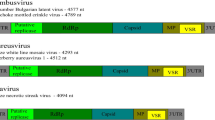Abstract
Three dsRNA segments were detected in Fusarium pseudograminearum strain CF14029, a pathogen causing Fusarium crown rot in China. Characterization and sequence analysis confirmed that these dsRNA sequences originated from the same virus. The viral genome consists of three dsRNA segments: dsRNA1 (3,560 nt in length), encoding an RNA-dependent RNA polymerase (RdRp), dsRNA2 (2,544 nt in length), encoding a hypothetical protein, and dsRNA3 (2,478 nt in length), encoding a putative coat protein (CP). Phylogenetic analysis based on the RdRp and CP amino acid sequences revealed a high degree of similarity of this virus to members of the genus Alternavirus, family Alternaviridae, isolated from other Fusarium fungi. As a novel member of the genus Alternavirus, this virus was provisionally named "Fusarium pseudograminearum alternavirus 1" (FpgAV1). Like other alternaviruses found in Fusarium species, the positive-sense strand of each genomic dsRNA of FpgAV1 possesses a poly(A) tail and a distinctive 5'-terminal octamer sequence (5’-GCT GTG TG-3’). This is the first report of the genomic sequence of an alternavirus identified in F. pseudograminearum.


Similar content being viewed by others
Data availability
The complete genome sequence of FpgAV1 has been deposited in the NCBI database with the accession numbers OR754230, OR754231, and OR754232.
References
Kazan K, Gardiner DM (2018) Fusarium crown rot caused by Fusarium pseudograminearum in cereal crops: recent progress and future prospects. Mol Plant Pathol 19:1547–1562
Smiley RW, Gourlie JA, Easley SA, Patterson LM, Whittaker RG (2005) Crop damage estimates for crown rot of wheat and barley in the Pacific Northwest. Plant Dis 89:595–604
Wagemans J, Holtappels D, Vainio E, Rabiey M, Marzachì C, Herrero S, Ravanbakhsh M, Tebbe CC, Ogliastro M, Ayllón MA, Turina M (2022) Going viral: virus-based biological control agents for plant protection. Annu Rev Phytopathol 60:21–42
Kozlakidis Z, Herrero N, Ozkan S, Kanhayuwa L, Jamal A, Bhatti MF, Coutts RHA (2013) Sequence determination of a quadripartite dsRNA virus isolated from Aspergillus foetidus. Arch Virol 158:267–272
Kotta-Loizou I, Wu CF, Moriyama H, Coutts RHA (2022) Create a new family (Alternaviridae) accommodating one new genus (Alternavirus) and five new species. https://ictv.global/ictv/proposals/2022.001F.Alternaviridae_newfam.zip
Pielhop TP, Popp C, Fricke S, Knierim D, Margaria P, Maiß E (2023) Molecular characterization of two new alternaviruses identified in members of the fungal family Nectriaceae. Arch Microbiol 205:129
He H, Chen X, Li P, Qiu D, Guo L (2018) Complete genome sequence of a Fusarium graminearum double-stranded RNA virus in a newly proposed family, Alternaviridae. Genome Announc 6:10–1128
Zhang X, Xie Y, Zhang F, Sun H, Zhai Y, Zhang S, Yuan H, Zhou L, Gao F, Li H (2019) Complete genome sequence of an alternavirus from the phytopathogenic fungus Fusarium incarnatum. Arch Virol 164:923–925
Wen C, Wan X, Zhang Y, Wei H, Zhong C, Zhang R, Shi H, Xie Y, Fu J, Zhao Y (2021) Y Molecular characterization of the first alternavirus identified in Fusarium oxysporum. Viruses 13: 2026
Osaki H, Sasaki A, Nomiyama K, Tomioka K (2016) Multiple virus infection in a single strain of Fusarium poae shown by deep sequencing. Virus Genes 52:835–847
Lutz T, Japić E, Bien S, Langer GJ, Heinze C (2022) Characterization of a novel alternavirus infecting the fungal pathogen Fusarium solani. Virus Res 317:198817
Mokhtari S, Ali A (2023) Identification and complete genome sequence of an alternavirus from a pathogenic fungus, Fusarium nanum, collected by air sampling. PhytoFrontiers 3:278–283
Zhang X, Wu C, Hua H, Cai Q, Wu X (2023) Characterization of the first Alternavirus identified in Fusarium avenaceum, the causal agent of potato dry rot. Viruses 15:145
Kearse M, Moir R, Wilson A, Stones-Havas S, Cheung M, Sturrock S, Buxton S, Cooper A, Markowitz S, Duran C, Thierer T, Ashton B, Mentjies P, Drummond A (2012) Geneious basic: an integrated and extendable desktop software platform for the organization and analysis of sequence data. Bioinformatics 28:1647–1649
Zhang X, Zhang H, Ma D, Chen H, Li W (2020) Novel positive-sense single-stranded RNA virus related to alphavirus-like viruses from Fusarium graminearum. Arch Virol 165:487–490
Katoh K, Standley DM (2013) MAFFT multiple sequence alignment software version 7: improvements in performance and usability. Mol Biol Evol 30:772–780
Tamura K, Stecher G, Kumar S (2021) MEGA11: molecular evolutionary genetics analysis version 11. Mol Biol Evol 38:3022–3027
Wu CF, Aoki N, Takeshita N, Fukuhara T, Chiura XH, Arie T, Kotta-Loizou I, Okada R, Komatsu K, Moriyama H (2021) Unique terminal regions and specific deletions of the segmented double-stranded RNA genome of Alternaria alternata virus 1, in the proposed family Alternaviridae. Front Microbiol 12:773062
Funding
This work was supported by the National Key R&D Program of China (grant no. 2022YFD1400105), the National Natural Science Foundation of China (grant no. 32072375), and the earmarked fund of the China Agriculture Research System (CARS-3-34).
Author information
Authors and Affiliations
Contributions
All authors contributed to the study conception and design. Material preparation, data collection, and analysis were performed by Lele Xia, Shulin Cao, and Haiyan Sun. The first draft of the manuscript was written by Fuyu Liu, and all authors commented on previous versions of the manuscript. All authors read and approved the final manuscript.
Corresponding authors
Ethics declarations
Conflict of interest
All of the authors declare that they have no conflict of interest.
Ethical approval
This article does not contain any studies with human participants or animals performed by any of the authors.
Additional information
Communicated by Ioly Kotta-Loizou
Publisher’s Note
Springer Nature remains neutral with regard to jurisdictional claims in published maps and institutional affiliations.
Electronic Supplementary Material
Below is the link to the electronic supplementary material
Rights and permissions
Springer Nature or its licensor (e.g. a society or other partner) holds exclusive rights to this article under a publishing agreement with the author(s) or other rightsholder(s); author self-archiving of the accepted manuscript version of this article is solely governed by the terms of such publishing agreement and applicable law.
About this article
Cite this article
Liu, F., Xia, L., Cao, S. et al. A novel alternavirus with three dsRNA segments from Fusarium pseudograminearum, the pathogen of Fusarium crown rot in wheat. Arch Virol 169, 49 (2024). https://doi.org/10.1007/s00705-024-05982-z
Received:
Accepted:
Published:
DOI: https://doi.org/10.1007/s00705-024-05982-z




